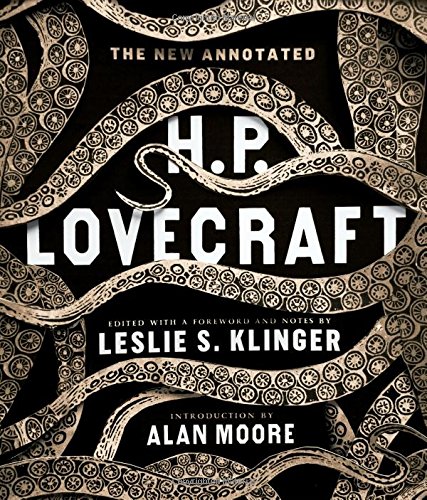The New Annotated H. P. Lovecraft
 Buy the Book:
Buy the Book:Amazon
Apple Books
Barnes & Noble
IndieBound
Books-A-Million
Published by: Liveright
Release Date: October 13, 2014
Pages: 928
ISBN13: 978-0871404534
OVERVIEW
From across strange aeons comes the long-awaited annotated edition of “the twentieth century’s greatest practitioner of the classic horror tale.” —Stephen King
“With an increasing distance from the twentieth century . . . the New England poet, author, essayist, and stunningly profuse epistolary Howard Phillips Lovecraft is beginning to emerge as one of that tumultuous period’s most critically fascinating and yet enigmatic figures,” writes Alan Moore. But at the time of his death, Lovecraft was maligned by critics and ignored by the public. Now, Leslie S. Klinger reanimates Lovecraft as never before, charting the rise of the pulp writer, whose rediscovery is almost unprecedented in American literary history. Following a trajectory not unlike Melville or Poe, Lovecraft’s vast body of work—a mythos in which humanity is a blissfully unaware speck in a cosmos shared by ancient alien beings—is increasingly being recognized as the foundation for American horror and science fiction.
With nearly 300 illustrations and more than 1,000 annotations, Klinger illuminates every hidden dimension of 22 of Lovecraft’s most canonical works.
ERRATA
On page xlvii, in the first full paragraph, fourth and fifth lines, delete the phrase “a rate never achieved by Lovecraft”
Delete note 17, p. 43, in its entirety, and substitute the following:
Plate XI curiously depicts a variety of animals, all exotic but quite realistic, with the exception of what the narrator terms a “dragon”—a dog-sized alligator-like creature with wings and a considerable curling tail.
Delete the first sentence of note 23, p. 51, and replace it with the following:
Epidemic typhoid is caused by the ingestion of food or water contaminated with the feces of an infected person containing the bacterium Salmonella enterica subsp. enterica, serovar Typhi, and prior to the discovery of the efficacy of sanitation and development of vaccines and antibiotics, had a high fatality rate.
Delete note 24, p. 52, in its entirety, and substitute the following:
Described later (in Part VI, “The Tomb-Legions”) as fifty miles from West’s home in Boston, Grafton State Hospital was actually about 34 miles west of Boston, in North Grafton, Massachusetts, at the junction of the Grafton, Shrewsbury, and Westborough town lines. Opened in 1901 and closed in 1973, it was an adjunct of Worcester State Insane Hospital, Worcester, Massachusetts, designed to house the chronically insane patients; it was not separately administered until 1912. Its significance is explained later in the story.
On page 115, replace note 3 with the following:
The town is clearly Arkham (see the first sentence of the story), and this is a clue that Arkham is to be identified with Salem. In a letter in 1927, Lovecraft pointed out “an ancient slab half engulfed by a giant willow in the middle of the Charles St. [sic] Burying Ground in Salem” [Lovecraft to Bernard Austin Dwyer, June 1927, reproduced in Selected Letters, II, 139.] While it's possible that Lovecraft misremembered the cemetery's name (there is no "Charles St. Burying Ground" in Salem or anywhere else--rather, there is a Charter St. Burying Ground in Salem, the oldest in the town), it is more likely that the transcription of this letter by the editors of Selected Letters was erroneous. The original of the letter is no longer available.
On page 202, first line, the word “scow” (before the name Fortaleza) should be “snow” and new footnote 95A should be inserted immediately following “snow” as follows:
In some editions, the word is erroneously changed to “scow,” but a “snow” is indeed an 18th-century sailing vessel, a two-masted schooner. The brigs Lawrence and Niagara, which took part in the Battle of Lake Erie (1813), were snows.
On page 240, note 168, add at the end, before the period:
(although the New York Post, first published in 1801, makes the same claim)
On p. 208, delete the sentence “In a letter dated 1928, Hutchinson states…”
On page 328, note 22, the word “specifically” should be inserted before the word “mentioned,” and the following sentence should be added at the end: “A ‘heavy stick he had picked up in the attic’ is mentioned shortly but without explanation of why it was in the attic.”
On page 343, in the lead paragraph to “The Dunwich Horror,” “Ambrose Bierce’s ‘The Wendigo’” should be “Algernon Blackwood’s ‘The Wendigo’”
On page 346, note 9, reference is made to “The Call of Cthulhu (pp. 123-57, above” and should instead be to “The Shadow Over Innsmouth (pp. 573-642, below).”
On page 456, the film poster is improperly credited to GraveHill Productions, 2007; the correct credit is “(H. P. Lovecraft Historical Society, 2011).”
On page 483, the footnote should be completely replaced with “Pteridophytes are ferns with roots, stems, and leaves, but no flowers or seeds. Spore cases are usually found under the pinnules at the ends of the leaves.”
Insert a new footnote 10A to page 814, in the fifth line of the first full paragraph, following the date “(1228)” as follows:
Lovecraft made an error regarding the date of Wormius’s translation: He was born in 1588, and his work must have appeared in 1628, not 1228. (See “The Festival,” note 20, above.)
On page 827, note 2, “Barclay Square” should be “Berkeley Square.”
On page 851, line 8, “Peter Horrocks” should be “Thomas Horrocks”